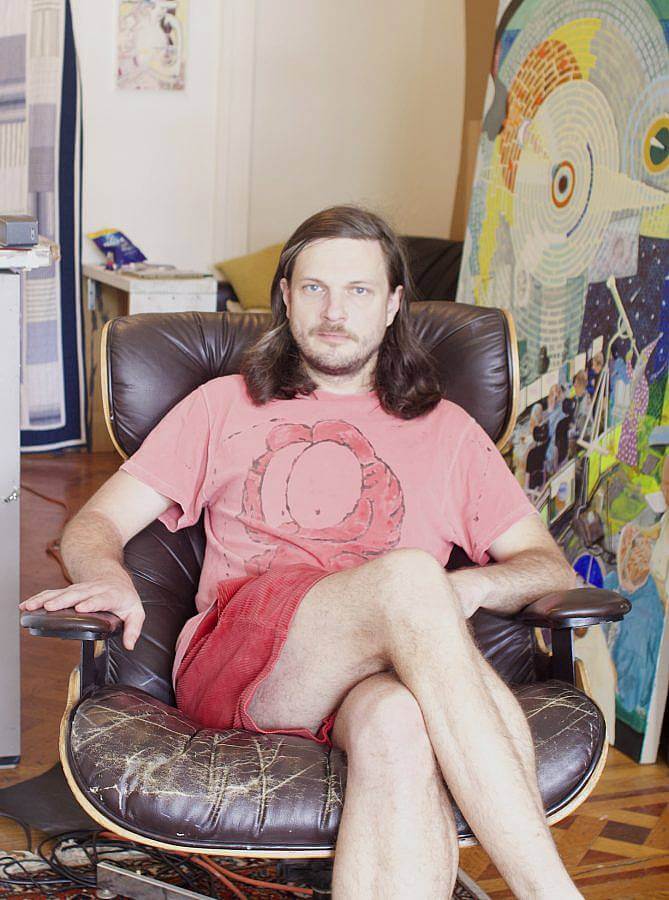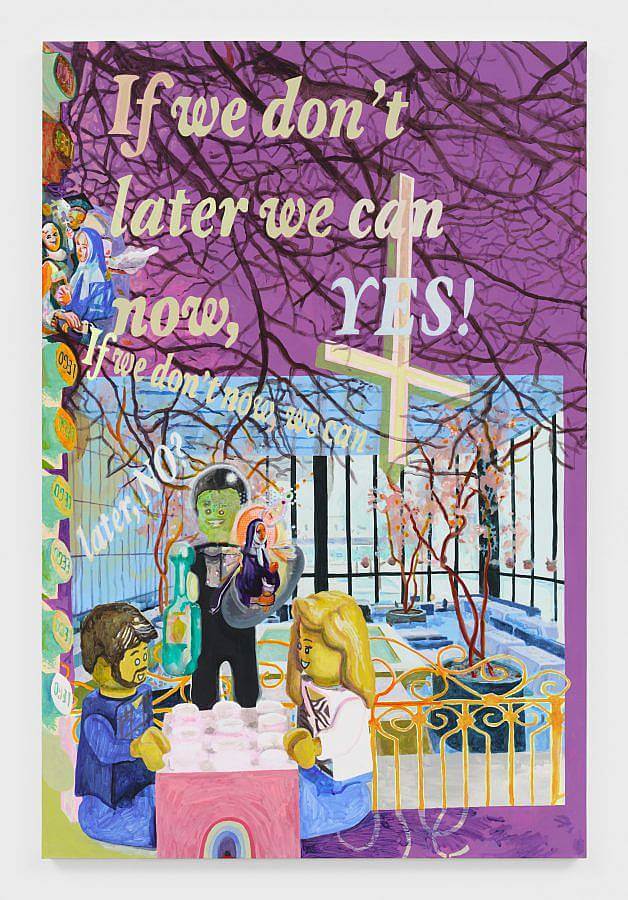
Tell us a little bit about yourself and what you do.
I’m a 39-year-old artist, and I’ve lived in New York for the better part of 20 years. I’m a painter primarily. I’m interested in mediated images and how they move from institutional/mass culture to a more internalized, handmade space. I also do performances and books, which also play with ideas of presentation and packaging.
Could you describe your practice as well as a bit of your process?
My practice currently revolves around painting, drawings and occasional performances. I struggle to work linearly, so I usually nurse 6 or 8 paintings at a time, often in slight variations of a single idea or image. I work quickly to start: I make a collage using a projector, or from a sketch, I block the spine of the painting in, and then it enters a kind of doodle space of trial and error where more abstract elements coagulate and color decisions are refined. This can take a long time, which is why I bounce around. However, performances or book projects require all my focus; probably because they involve more research and writing. Those types of projects tend to generate ideas for paintings though, so it’s all cyclical.
How did your interest in art begin and how did you get to where you are focused in now?
I was a young comic book fan at a time when that field was trying to position itself (correctly) as a legitimate art form, so my nerdy Marvel interest naturally led me to learn about pop art, semiotics, and irony. I probably had a deep insecurity about just how into comics I was. I also sought to legitimize it, which led me through art history into painting, which seemed vast, difficult, and mysterious to me. I still feel that way. I never even really made comics. Painting is basically all I’ve ever wanted to do since.
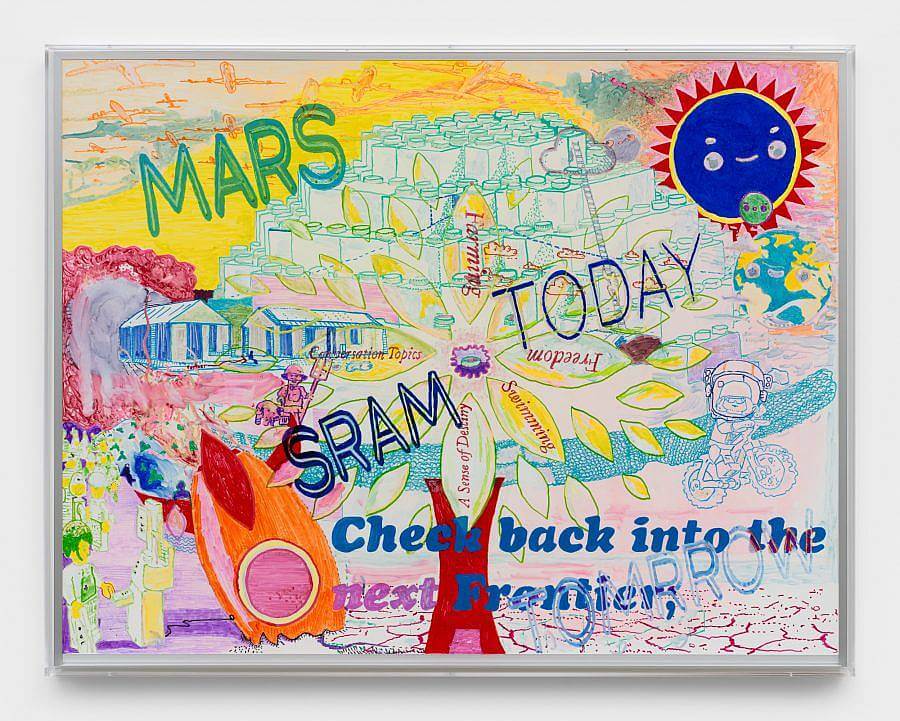
Your paintings are filled to the brim with multitudes of images and words, I can’t help but relate this to the constant flood of images the internet gives us on the daily and how it manifests in our brains/memory-like flashes. Can you talk a bit on this? How has the internet influenced your work? How do you use it as a tool/another “material”?
I’ve always been drawn to text as an element in painting. In my twenties, I had a project of painting newspaper pages as just rows of brushmarks, like a pastoral landscape or something. I was already nostalgic for a daily “paper”. This is still how I think about my work: in terms of attention, except obviously, we now live in a much more manic environment. Many of my images come from the internet, but, as you suggest, the material is more thinking about the brain, and how it’s responding to what it’s receiving. I’ve had ADHD since I was young, but now that’s just life–more vibe than diagnosis–our eyes can’t help but take it all in. I take a lot of inspiration from advertising: like internet spam, subway ads, and more generally graphic design that demands to be read, but is designed to be flirtatious, confusing or just generally intriguing.
In our email thread we talked about the importance (and lack) of interviews within the art world and you mentioned that you ran an interview podcast. Can you talk about this project and your experience with it? Why are interviews important to you?
I was excited when you reached out. I’ve always been into para-social experiences in general, and growing up I read a lot of interviews in what was then a fairly active time for the comics industry press. I always wished there were more forums for interviews in the fine arts. I now understand that there’s just a totally different set of incentives for artists operating in this part of the art world. Silence and aura are more the coin of the realm. So it’s been a recurrent interest that has intersected with my studio practice in a significant way.
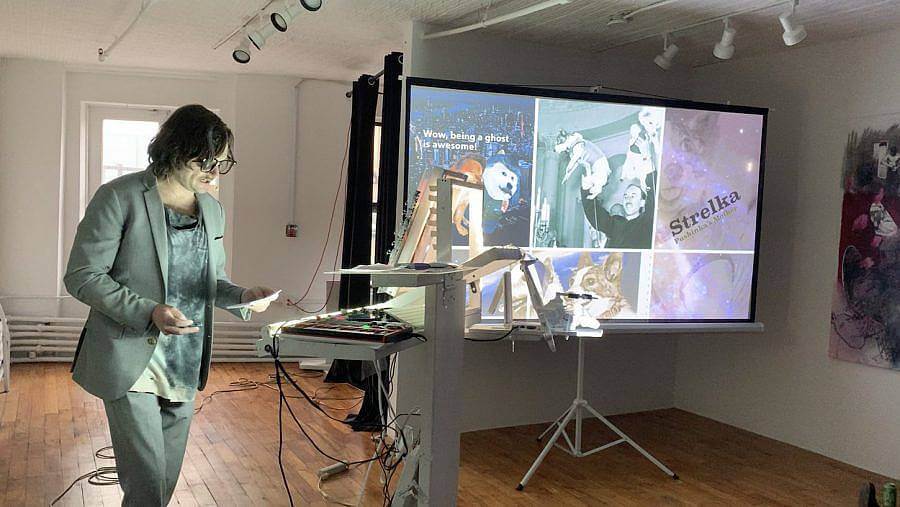
First, I ran a lecture series with some friends–an informal place for people to talk about their interests; which opened me up to performing and giving lectures myself, which were more satirical, involving drawings and eventually whiteboards. When the lecture series ended, I returned to the initial idea: an art conversation, which led to starting a podcast with my friend Cat Kron called Induction Burners. Cat was working as an editor at Artforum at the time, and we both wanted a fun outlet. A conversation podcast is also like the dialectical flip of a lecture performance, and I also really enjoyed editing (most episodes). We had a pretty good run for a few years and it evolved a lot. We had really fun conversations with a good range of artists, but mostly people we knew a little in New York. I’m honestly still proud of it even though it was always a very niche thing.
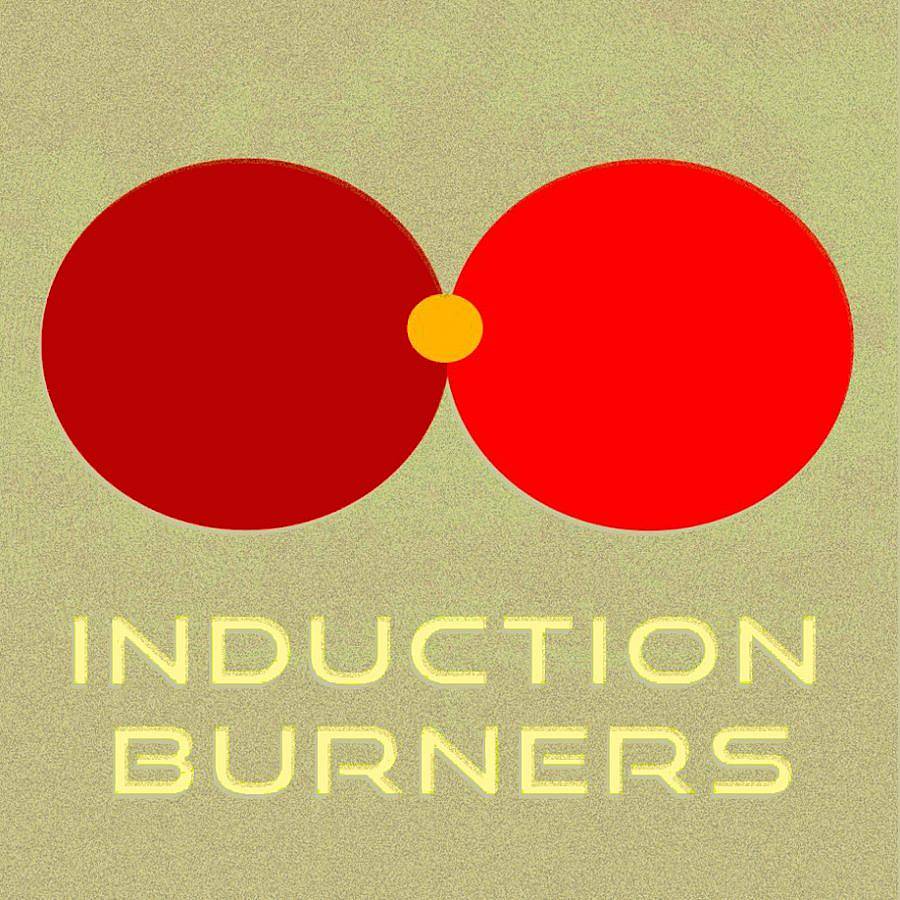
With artists, there is always a personality structuring the work. When you’re young that can be totally opaque, and you just want a peek behind the curtain. Like: what the hell are they really doing in there? In the comics press, artists would talk about their methods in great detail, and would be pretty transparent about the industrial conditions involved in making their work, either for hire or pleasure, and they would go on for pages. In our art world (whatever that is), there are some artists and forums like that; I think of Parquet, Artforum sometimes, Interview is fun, but I think there’s more to be done and in a longer form. The Smithsonian has an amazing archive of interviews with painters that is more nuts and bolts and historical, and those have stuck with me.
A big ‘but’ here: I’ve also come to understand the need for mystery and silence on the part of artists, to let their art speak for themselves, and also because sometimes we don’t know what we’re talking about, or even what the work is really about. All these factors make for a lively (and fun) tension if not taken too seriously. That is what we tried to do on our podcast, and also to have artists interview their friends, like Interview magazine, I guess.
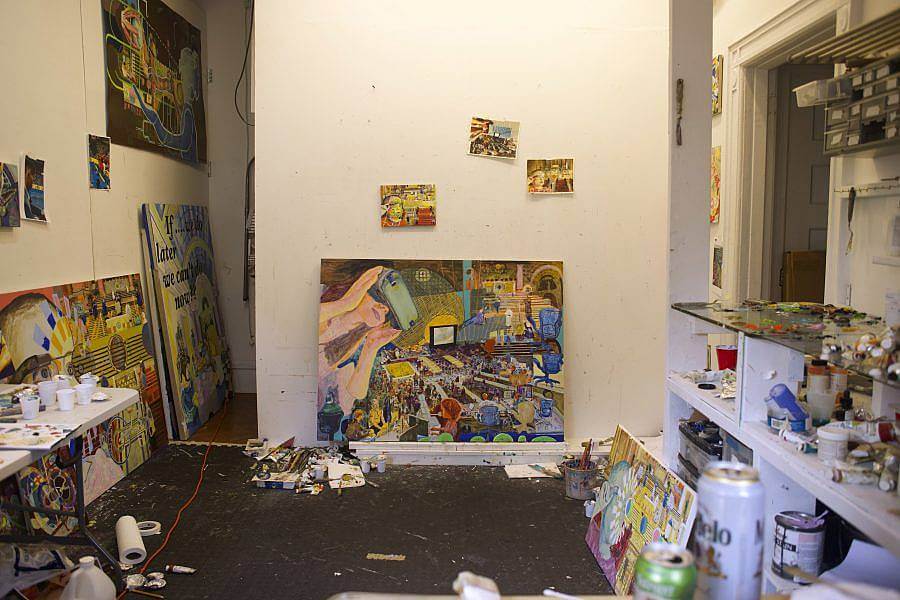
Describe your current studio or workspace.
My studio is in my apartment, which is a two-bedroom railroad in Sunset Park. I’ve lived there for a long time now and have built out an intricate system that really works for me. I have the best landlords in New York, and they’ve made it possible for me to have a live-work situation that isn’t depressing. I hope they don’t regret it.
What is one of the bigger challenges you and/or other makers are struggling with these days and how do you see it developing?
In New York, the crisis of real estate and housing feels like it’s affecting a lot of what is made and shown here. That’s not particularly new but since COVID it has felt like an even further shift and it’s hard to see that changing anytime soon. There is a feeling of contraction, and turnover, a shifting sense of what’s possible. I do also feel like those who lived through the pandemic have a bunkered commitment to just pushing onward.
I think the Biden years feel like this waiting room between the past and the future; like change can’t come fast enough but no one’s making the first move, and so history has a really weird shape right now–no clear horizon. Art-making is a reflection in the sense that you do see a lot of energy on the horizon and good work being done, but the transaction tax of doing anything is just rising.
One thing I think about a lot is how rough and small the art world felt after the financial crash in 2008, certainly in New York, and how much bigger it is now, even if it’s reverting to the mean, or the middle. There’s a lot of opportunity, but also I’ve seen a flight to painting as a safe medium. That’s not a judgment, I certainly feel it too.

Across your paintings, there’s a diagram-esque layout as well as references to scientific imagery and so on. What is the significance of this imagery for you?
I think diagrams combine a lot of my core concerns: looking as a form of reading, drawing as a form of writing, maps and “publics”, charts and media, pictographs and cartoons. I think of diagrams as a kind of figure, and inside the paintings they are set in tension with other elements. Control and order versus excess and chaos–these are the voices in the conversation I want to create. In my texts and lectures, I think of a character, who is the author, trying to keep himself in control by repeating something to themself, and their sense of self starts to become their only reality. I think of diagrams the same way. They propose a true, structured universe, which we know is just a kind of rhetoric, and at their best have a spiritual aspiration, which is also ridiculous.
How do you use layering and overstimulation to build language throughout your practice? Can you speak about what it means to have so many different images and themes interact with one another in one painting? Are you attempting to create through-lines or is it about disconnect?
My performances have a kind of fake TED talk vibe; I used office supplies, and I eventually started making drawings on whiteboards. This is where I figured out what I wanted to do visually. I was able to work on something for a long time, but could change and refine something until it became something else entirely. It forced me to spend insane amounts of time drawing straight lines to fill a field of color, but it also opened up a kind of doodle space. So now I can project a Photoshop collage, and then tinker. I learned to work really slowly, and the paintings have become much denser. I want to give people something to look at, and let the collisions spread out.
As for disconnects, this may be a tangent, but: when I think about what makes a good joke, people always say it’s making sense out of nonsense, which is something they also say about conspiracy theories, etc. Sometimes it’s with just the barest thread. “They can kill the Kennedy’s, why can’t they make a cup of coffee.” That’s kind of the way I think about making art, and painting just happens to be what I like to do most.
What is influencing your work right now?
The dread I have about the future and the joy I have right now.
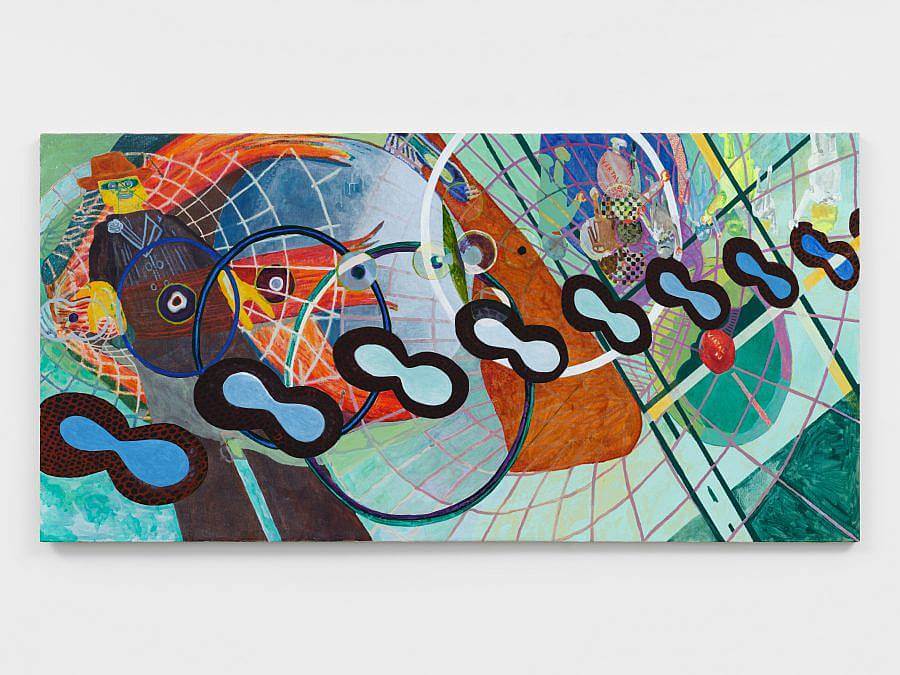
You take what might seem recognizable (the LEGO minifigure, a brand name) and distort it to change its meaning completely. What is the significance of working with such popular symbols and names? How are you using them to bring forth themes that are common throughout your work?
Since my work can be really dense, I’ve always tried to have some sort of hook that offers people a readable entry point–a connection with the real world. LEGO is many things, and it’s a simple visual system that connects to things like Minecraft or Hollywood, but is also just a way of structuring how people will view the work a little bit. I like to work with topics that are a little overdetermined, like, LEGOs, newspapers, the Beltway Sniper, Gallup, Joe Biden, or Mars. All of these things are like these conceptual nodes that point to our time and place in the history of America.
I know other people don’t always see it this way, but I see these loaded topics as space of openness, or a starting point, on which other ideas can be grafted. In that way, the process of making the work is a further mediating or drifting away from where it started.
What do you want a viewer to walk away with after seeing your work?
I want people to have a visual buzz, and feel excited. Whatever my own pretensions and ambitions, I think the work lives or dies on its color and formal qualities, especially in painting. I think that’s the compact with the viewer. Beyond that, I think we all tune out a tremendous amount on a day-to-day basis, and I would like people to pause and enjoy the mundane texture of everyday life.
Do you have any daily rituals?
I walk a lot. What’s the line between ritual and addiction? Twitter!
What have you been listening to/reading lately?
I listen to more podcasts than anyone I know and I always have; there’s one called Tech Won’t Save Us which is about the tech industry from a softly Marxist perspective, and it’s really helped me process what’s happening in Silicon Valley. I suppose related to some things here, I’ve been listening to Azaelia Banks. Acknowledging that she’s problematic, I think she’s really funny and makes music using words in a really addictive way.
